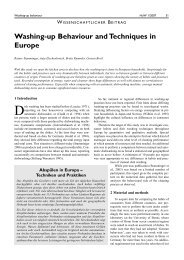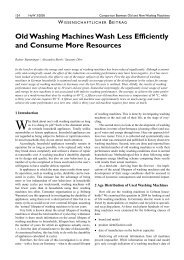Development of a novel mechatronic system for mechanical weed ...
Development of a novel mechatronic system for mechanical weed ...
Development of a novel mechatronic system for mechanical weed ...
You also want an ePaper? Increase the reach of your titles
YUMPU automatically turns print PDFs into web optimized ePapers that Google loves.
Introduction<br />
than 40 years be<strong>for</strong>e germination. The timing and method <strong>of</strong> soil management<br />
have a great influence on the dormancy or germination <strong>of</strong> the <strong>weed</strong> seeds.<br />
Weeds compete with crops <strong>for</strong> moisture, light, nutrients and space, and<br />
there<strong>for</strong>e their elimination is <strong>of</strong> high importance. An understanding <strong>of</strong> the crop-<br />
<strong>weed</strong> competition combined with the knowledge <strong>of</strong> <strong>weed</strong> characteristics and<br />
behaviour can be critical in establishing an optimal <strong>weed</strong> management <strong>system</strong>,<br />
or more exactly the timing <strong>of</strong> <strong>weed</strong>ing operations. For most crops there exist a<br />
critical period during which <strong>weed</strong>s must be controlled to maintain the yield.<br />
Studies to determine the critical <strong>weed</strong>ing periods under conventional growing<br />
<strong>system</strong>s have been done <strong>for</strong> almost all crops. However, in the period<br />
immediately after emergence, experiments showed that <strong>weed</strong>s present on the<br />
field had little effect on the crop yield, as also after the critical period. Crop<br />
species are tolerant to early <strong>weed</strong> competition without yield loss in certain<br />
periods during their growth, whereas <strong>weed</strong>-free periods are required in other<br />
development stages <strong>of</strong> the crop plants to prevent yield loss (Zimdahl 1980;<br />
Grundy et al. 2003). Besides, <strong>weed</strong> species have distinct periods <strong>of</strong> germination<br />
and seasonal patterns <strong>of</strong> <strong>weed</strong> emergence, which are experimentally examined<br />
under the conventional growing <strong>system</strong> (Lampkin 1990; Naylor 2002). This<br />
in<strong>for</strong>mation can help to choose the optimal timing <strong>for</strong> operations such as<br />
cultivation, sowing and <strong>weed</strong>ing, according to the peak time <strong>for</strong> germination<br />
periods <strong>of</strong> the predominant species.<br />
10<br />
1.4 Organic <strong>weed</strong> management<br />
Successful organic <strong>weed</strong> control involves the combination <strong>of</strong> various operations<br />
and cultural management methods. The right approach in organic <strong>weed</strong><br />
management planning has to be <strong>system</strong>atic and should start with the highest<br />
<strong>system</strong> level and descend to the lowest. If some levels are omitted or missing,<br />
the result will reflect on the yield directly or cause significant problems in the<br />
next season. The ultimate aim <strong>for</strong> all organic farmers is to prevent development<br />
<strong>of</strong> the annual <strong>weed</strong>s to the stage when they are able to produce seeds and to<br />
restrict the dispersal and growth <strong>of</strong> perennial <strong>weed</strong>s (Taylor and Zenz 2006).





